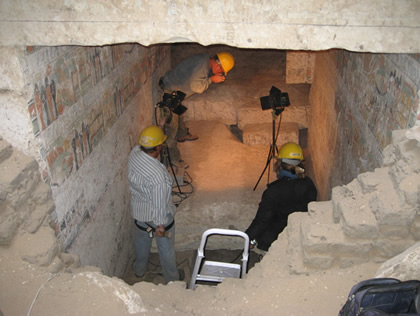Abydos is located in Upper Egypt on the west bank of the Nile River and is situated in the desert at the edge of the river's floodplain. The site has been significant since the Predynastic period (beginning in 4800 B.C.). Abydos was a desirable burial site in the ancient world, not only for kings and other important officials, but also for regular people. The ancient Egyptians believed that the entrance to the underworld was at Abydos, at the mouth of a large, dramatic-looking wadi (dry river bed).

Conservator working at Abydos.
The primary conservation goal at Abydos is to preserve fragile organic artifacts, like painted wood statues and textiles, which are excavated at the site. Wood artifacts found at the site often have beautiful, painted surfaces, but the wood itself is severely degraded and bug-eaten. It is often so fragile that it cannot be touched without causing damage.
To excavate fragile artifacts like these, conservators apply a temporary consolidant called cyclododecane, a wax that is melted and dripped onto the object. This wax hardens quickly, making the artifact strong enough to be lifted from the ground. Depending on the condition of the object, it is then wrapped in plastic to keep the wax in place, or left unwrapped, which will allow the wax to sublime. Sublimation means that a substance can go right from a solid to a gas, skipping the liquid phase. So to remove the wax, conservators need only to leave the object unwrapped with good airflow.

Conserving objects on site with hot cyclododecane.
Ongoing conservation goals at Abydos are to improve conservation treatments for organic artifacts following excavation, and to improve storage for excavated artifacts. Conservators also work to stabilize architectural features when necessary.

Photographing a tomb at Abydos.
